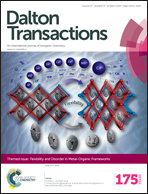Explaining the mechanical mechanisms of zeolitic metal–organic frameworks: revealing auxeticity and anomalous elasticity
Abstract
The comprehensive elastic properties of Zeolitic Imidazolate Frameworks (ZIF-1 to ZIF-4) have been computed using density functional theory (DFT). We employed the periodic CRYSTAL14 code to calculate the single-crystal elastic coefficients (Cij) at the B3LYP level of theory. While the chemical compositions of ZIFs-1 to -4 are the same, each structure features a distinct network topology, crystal symmetry and porosity configuration, which translate into differential structure-function mechanical correlations. We elucidate the anisotropic mechanical response with respect to the directionally dependent Young's and shear moduli properties. Our theoretical results suggest that ZIF-3 adopting a dft topology has an extremely low shear resistance (Gmin = 0.1 GPa), which is also underpinning the flexible mechanism responsible for its negative Poisson's ratio (auxetic νmin = −0.43). Interestingly, we identified that ZIF-1, ZIF-2, and ZIF-4 could exhibit a nearly zero Poisson's ratio for certain crystal orientations, which is reminescent of a rare “cork-like” phenomenon where there is practically no lateral deformation corresponding to an applied axial strain. Furthermore, we determined the bulk moduli and linear compressibilities, alongside the averaged elastic properties of the ZIF polycrystals.

- This article is part of the themed collection: Flexibility and Disorder in Metal-Organic Frameworks

 Please wait while we load your content...
Please wait while we load your content...